


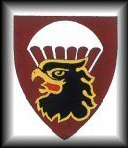
Introduction
During the Border War South Africa fought from 1966 to 1989 against SWAPO, FAPLA, and Russia's surrogate Cuban troops, there never was an operation that had more chance of going wrong than operation Reindeer, the attack on SWAPO's operational headquarters for Southern Angola , but the rewards would be great, the people of South West Africa would be able to have free and fair elections without SWAPO terrorists intimidating and torturing them.
The indigenous people were caught
between a rock and a hard place, when Swapo arrived , so called
"Sell-outs" would be made examples of, babies would be
killed and their 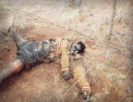 mothers forced to eat their flesh,
if a headman was neutral , Sam Nujomas' henchmen would quickly
sway popular opinion by publicly executing him as an
mothers forced to eat their flesh,
if a headman was neutral , Sam Nujomas' henchmen would quickly
sway popular opinion by publicly executing him as an 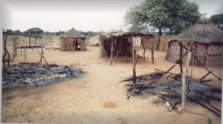 example to
those who did not toe the party line, if this failed a number of
victims would be picked at random , and the local population ,
known as "PB's" (Plaaslike Bevolking) would be
coerced into killing these, whilst singing the praises of PLAN
(the military wing of SWAPO) , if this did not have the desired
effect a kraal would be torched as an example to those who did
not agree with Nujoma's idea of democracy. South African troops
often came upon the corpses of these unfortunates, and could only
wish that those in the outside world who always accused South
Africa of being the villain of the peace could be present when
they had to transport one of SWAPO's victims bodies back to those
who would be grieving for them.
example to
those who did not toe the party line, if this failed a number of
victims would be picked at random , and the local population ,
known as "PB's" (Plaaslike Bevolking) would be
coerced into killing these, whilst singing the praises of PLAN
(the military wing of SWAPO) , if this did not have the desired
effect a kraal would be torched as an example to those who did
not agree with Nujoma's idea of democracy. South African troops
often came upon the corpses of these unfortunates, and could only
wish that those in the outside world who always accused South
Africa of being the villain of the peace could be present when
they had to transport one of SWAPO's victims bodies back to those
who would be grieving for them.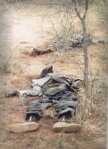
On October 27, 1977, a SWAPO gang numbered 80 plus crossed the Jati, and decided to try and take on a Security Force patrol numbering 18 , this turned out to be major miscalculation as the South African commander decided that offence was the best form of defence and after a running battle lasting three days the South Africans emerged as the victors. SWAPO lost 61 KIA , our losses were 5 KIA, this battle proved to be a turning point, from now on the South African authorities decided that they would fight the war on Angolan soil , as SWAPO and their Marxist allies had chosen to sow the wind , they would have to accept the fact that they would reap the whirlwind. The stage was set to hit SWAPO hard and often, this pattern would continue in the years to come.......
The Plan
The Genesis of Operation Reindeer was Operation " Bruilof" ( Wedding ), initially scheduled for April 1978, this envisaged South African Forces attacking six SWAPO bases in and around Chetequera, but then fate intervened, and "Bruilof" was expanded to encompass an obscure mining town called Cassinga , Chetequera, and a heli-borne assault on a variety of SWAPO camps in the vicinity of these.
As a result of intelligence reports
the town of Cassinga had become a very interesting target for
South Africa, during the border war South Africa had built up an
extensive Sigint capability in countries such as Malawi,
Rhodesia, and the Comores Islands, and these sources as well as
Humint gained by South African Reconnaissance Commandos had
catapulted Cassinga into the spotlight, the sleepy mining village
on a tributary of the Cubango was a target worth hitting hard,
despite the risks involved, this quiet backwater had become a
complex training 700 to 1200 terrorists, the whole town was
surrounded by an extensive trench system, with bunkers mutually
supporting each other , and anti-aircraft guns that would be
deployed against the South Africans in a ground role , something
they were not aware of at the planning stage , this was going to
a hard nut to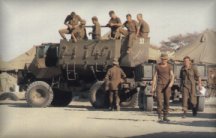 crack indeed.
crack indeed.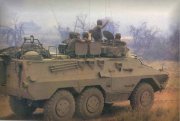
During this operation the South African Forces involved in the ground attacks would also try out new tactics and battle-test new equipment , the Ratel (Badger) Infantry Fighting Vehicle , armed with a 20 mm cannon (later on this would be up-gunned to 90mm , and take on Soviet T55 tanks , and come off best) The Buffel (Buffalo) mine protected vehicle, based on a Unimog chassis These vehicles would become a major export successes , with countries like Morocco, Saudi Arabia, Sri Lanka buying these.

 The ground troops'
personal weapons would not be the Israeli Galil, that
fired a 5.56mm round , the airborne element of
Operation Reindeer would still be armed with the South African
version of the Belgian FN rifle the R1 , later on all
forces in the South African Defence force would be armed with the
Galil, but these would be produced under license in South Africa
, and would be known as the R4, Most of the Parabats who dropped
at Cassinga would come to appreciate the superior stopping power
of the 7.62 x 51 R1 round, a number of terrorists who were holed
up in buildings at Cassinga were neutralised by the simple
expedient of firing through walls, a feat that the R4 was
incapable of.
The ground troops'
personal weapons would not be the Israeli Galil, that
fired a 5.56mm round , the airborne element of
Operation Reindeer would still be armed with the South African
version of the Belgian FN rifle the R1 , later on all
forces in the South African Defence force would be armed with the
Galil, but these would be produced under license in South Africa
, and would be known as the R4, Most of the Parabats who dropped
at Cassinga would come to appreciate the superior stopping power
of the 7.62 x 51 R1 round, a number of terrorists who were holed
up in buildings at Cassinga were neutralised by the simple
expedient of firing through walls, a feat that the R4 was
incapable of.
Whilst the planning for Bruilof was
taking place, a problem that kept cropping up, was the fact that
Cassinga was 250 Kilometers from the South West African border,
any conventional assault would give the Terrorists ample
warning, the one of those involved , Lieutenant-General
Constand Viljoen proposed that an attack on Cassinga by
Paratroopers had to be the solution , as SWAPO would not
expect the South Africans to be so bold, and the element of
surprise would be make up for the lack of heavy weapons the
ParaBats would suffer from. 
The heaviest weapons the Parabats would have would be 60mm Mortars sans base plates the Patmor was still to come, to neutralize any armoured threat the Parabats would rely on RPG-7V rocket launchers , there was a certain irony in this, as the RPG7-V was the weapon of choice for SWAPO .Should the attackers find themselves under attack from Cuban and FAPLA forces the best that they could hope for was that the South African Air Force would be able to neutralize these forces and evacuate them by helicopter , but due to the Arms embargo against South Africa these were in short supply , especially the larger Super Frelons . The bulk of the rotary wing transport aircraft the SAAF had consisted of Puma helicopters that could only carry 10 troops to overcome this an HAA (Helicopter Admin Area) would have to be established inside Angola itself where the SAAF choppers would have to wait until the attack was over and done with, this itself was fraught with danger, should this be compromised the South Africans at Cassinga would be cut off with no means of escape.
A worrying development was the fact
that due to Sigint it became apparent that there was a mixed
Cuban/FAPLA force stationed at Techamutete a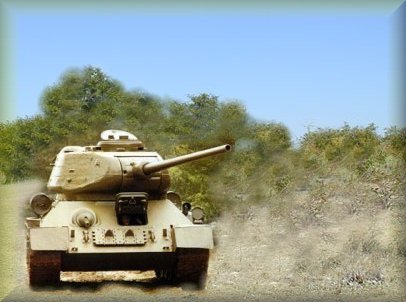 armed with T-34 tanks and BTR-152's
. By modern day standards these weapons were obsolete, and
against a conventional attack they would be easy meat, but
against the force that would be attacking Cassinga they would be
deadly, the T-34 carried an 85mm gun, the BTR-152 a 12,77 machine
gun and twelve troops , and should the Cubans decide to attack in
conjunction with air support in the shape of MIG-21's that had
been deployed in Angola since the end of December 1976, the
attackers would be slaughtered as the British Paratroopers had
been at Arnhem during Operation Market Garden in 1944
armed with T-34 tanks and BTR-152's
. By modern day standards these weapons were obsolete, and
against a conventional attack they would be easy meat, but
against the force that would be attacking Cassinga they would be
deadly, the T-34 carried an 85mm gun, the BTR-152 a 12,77 machine
gun and twelve troops , and should the Cubans decide to attack in
conjunction with air support in the shape of MIG-21's that had
been deployed in Angola since the end of December 1976, the
attackers would be slaughtered as the British Paratroopers had
been at Arnhem during Operation Market Garden in 1944
What Lt Gen Constand Viljoen was about to do had only been done once before , he was planning a to emulate a daring airborne raid on a stronghold deep in enemy territory, with no ground support, the previous one had been accomplished in May 1940..... when the Fallschirmjåger captured Fort Eben- Emael.
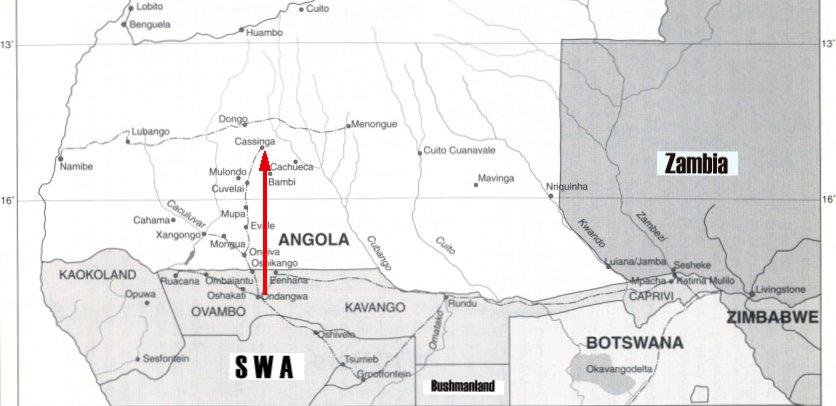
Preparation
A major worry for the SADF was the possibility that the plan might be compromised, and that the airborne assault would walk into a trap, during the early stages it had come to the attention of Military intelligence that the Angolans were expecting some sort of South African raid into Angola to pre-empt the buildup of terrorist forces there. A call-up of Citizen Force paratroopers would be a dead give-away that there might be a airborne raid in the offing , the ground phase of the operation involving the attack on Chetequera would be undertaken by National Servicemen whose movements were not in the public eye so the planners had few concerns about disguising the preparations for this phase
Lt Gen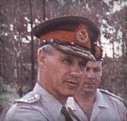 Constand
Viljoen and his staff decided to take advantage from the fact
that the SADF had planned large air and ground maneuvers during
May 1978 at Kimberley , and used this as a smokescreen to call up
the paratroopers , ostensibly to take part in this exercise
codenamed "Kwiksilwer" , but instead of going to
Kimberley they would go to De Brug just outside Bloemfontein
where they would rehearse the attack until just before D Day. On
23 March he informed General Magnus Malan that intelligence
sources had reported that SWAPO was predicting that the
forces outside Bloemfontein were being trained for an incursion
into Angola, the most likely source who informed SWAPO was the
traitor Commodore Dieter Gerhardt of the South African Navy, who
had been a Soviet Spy since the early sixties. In the weeks
leading up to the attack the ParaBats spent every hour they
were awake rehearsing their battle drills, the mortar crews
getting familiar with the concept of firing a 60mm mortar without
a base plate bipod and sights, "walking" the
explosions on to the target, the RPG gunners practicing Bunker
busting , Rifle platoons going through fire and movement., by now
most of them were aware that something was in the wind, this had
been the most intensive training they had ever been subjected to,
this was no exercise. On 30 A
Constand
Viljoen and his staff decided to take advantage from the fact
that the SADF had planned large air and ground maneuvers during
May 1978 at Kimberley , and used this as a smokescreen to call up
the paratroopers , ostensibly to take part in this exercise
codenamed "Kwiksilwer" , but instead of going to
Kimberley they would go to De Brug just outside Bloemfontein
where they would rehearse the attack until just before D Day. On
23 March he informed General Magnus Malan that intelligence
sources had reported that SWAPO was predicting that the
forces outside Bloemfontein were being trained for an incursion
into Angola, the most likely source who informed SWAPO was the
traitor Commodore Dieter Gerhardt of the South African Navy, who
had been a Soviet Spy since the early sixties. In the weeks
leading up to the attack the ParaBats spent every hour they
were awake rehearsing their battle drills, the mortar crews
getting familiar with the concept of firing a 60mm mortar without
a base plate bipod and sights, "walking" the
explosions on to the target, the RPG gunners practicing Bunker
busting , Rifle platoons going through fire and movement., by now
most of them were aware that something was in the wind, this had
been the most intensive training they had ever been subjected to,
this was no exercise. On 30 A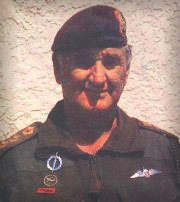 pril an full-scale dress
rehearsal was held, and on 2 May those taking part in the assault
were briefed by the man chosen to lead this force :-
Colonel Jan Breytenbach, the Enfant Terrible of the South
African Defence Force , if any man could claim to be a legend in
his own time , this man could, a veteran of clandestine
operations in Africa that spanned the Continent, from Nigeria
where he liased with General Ojukwu of Biafra, to sabotage
missions against Julius Nyerere's Tanzania for which he was
awarded the Honoris Crux Silver , to operations in Rhodesia
assisting that country in its fight against the Marxist forces of
Nkomo and Mugabe, in between all of that he found the time to be
the driving force for the creation of the Reconnaissance
Commandos , and also created 32 Battalion " The Terrible
Ones" the finest force Africa had ever seen since Scipio
Africanus and his Legions graced these shores during the Punic
Wars, his 2 IC was Commandant Lewis Brand. The assault force
consisted of:
pril an full-scale dress
rehearsal was held, and on 2 May those taking part in the assault
were briefed by the man chosen to lead this force :-
Colonel Jan Breytenbach, the Enfant Terrible of the South
African Defence Force , if any man could claim to be a legend in
his own time , this man could, a veteran of clandestine
operations in Africa that spanned the Continent, from Nigeria
where he liased with General Ojukwu of Biafra, to sabotage
missions against Julius Nyerere's Tanzania for which he was
awarded the Honoris Crux Silver , to operations in Rhodesia
assisting that country in its fight against the Marxist forces of
Nkomo and Mugabe, in between all of that he found the time to be
the driving force for the creation of the Reconnaissance
Commandos , and also created 32 Battalion " The Terrible
Ones" the finest force Africa had ever seen since Scipio
Africanus and his Legions graced these shores during the Punic
Wars, his 2 IC was Commandant Lewis Brand. The assault force
consisted of:
Alpha Company Bravo Company Charlie Company
Captain Gerrit Swart Captain Hugo McQueen Commandant Monty Forbes
Three Under strength Rifle Platoons, two 60mm Mortars Two Rifle Platoons, two 60mm Mortars Two Rifle Platoons, no support weapons
Delta Company Echo Company Independent Rifle Platoon
Captain Tommy Smit Major Wesley Fourie Lieutenant Johan Witt
Two Rifle Platoons, no support weapons Mobile reserve (120 men) Rifle Platoon
Independent Rifle Platoon HQ Company 44 Brigade HQ
Lieutenant Piet Botha Lieutenant Pierre Peters Brigadier M J Du Plessis
Rifle Platoon Two Platoons, RPG-7 & 60mm Mortars Intelligence, Engineering & Medical teams
The total force to be deployed was at least 1/3 below battalion strength, and most of the force consisted of Citizen Force Reservists , their peacetime occupations ranged from Diesel Mechanic to Accountant, Business Executive to Shunter, but the one thing that made all of these occupations meaningless was the Burgundy beret they all wore, the mark of the ParaBats .
Breytenbach's intelligence officer , Captain L Welman unveiled a detailed sand model of the target in the barn where the briefing was held , in addition to this reconnaissance photos that had been obtained by the SAAF had been hung on the walls. As usual Breytenbach did not mince his words, and impressed on his men that they had to hit the ground running, if you want to kill a paratrooper the quickest and easiest way is to hit him as soon as he lands, if you allow him to consolidate his position you've lost your chance.
This is how the attack was supposed to have happened, but as Napoleon said : " No plan of any attack survives after 5 minutes. " The drop on Cassinga proved to be no exception.....
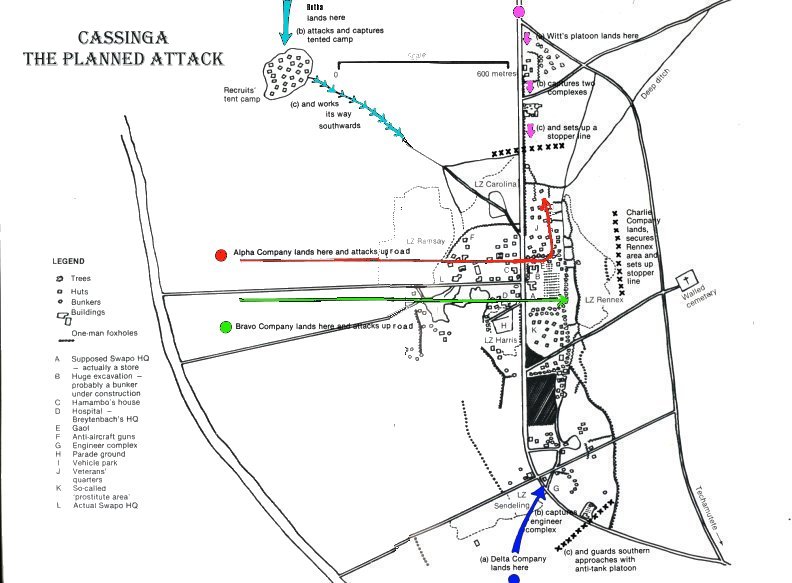
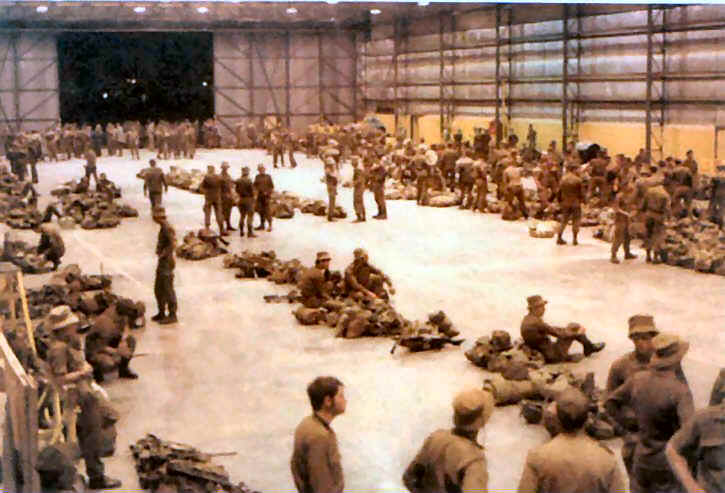
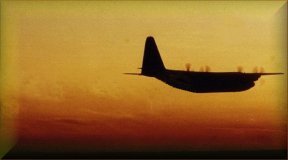 At 16h30 , 3 May the 'Bats took off from
Bloemfontein , they disembarked at Grootfontein at 20H30,
the troops whiled the time away by checking and re-checking
weapons and kit, weapons and magazines were stripped and cleaned,
increment charges for the 60mm Mortars were examined, rockets for
the RPG 7-Vs were checked, fresh batteries for the A52 radios
were inserted, comms checked, prayers were said, promises were
made , letters were written, good friends made promises, bibles
read, eventually some Parabats settled down to a fitful
sleep round about 22H00, their datewith Destiny was less than 6
hours away .....
At 16h30 , 3 May the 'Bats took off from
Bloemfontein , they disembarked at Grootfontein at 20H30,
the troops whiled the time away by checking and re-checking
weapons and kit, weapons and magazines were stripped and cleaned,
increment charges for the 60mm Mortars were examined, rockets for
the RPG 7-Vs were checked, fresh batteries for the A52 radios
were inserted, comms checked, prayers were said, promises were
made , letters were written, good friends made promises, bibles
read, eventually some Parabats settled down to a fitful
sleep round about 22H00, their datewith Destiny was less than 6
hours away .....
During the afternoon of 3
May , Waterkloof Air Force base was a hive of activity, SAAF
armourers were bombing up the 4 Canberra's with 300
"Golf" bombs each , these bombs were a Rhodesian
invention; designed to bounce 10 meters after hitting the ground
and then exploding, this was a anti-personnel weapon par exc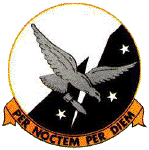 ellence, the 5 Blackburn Buccaneers of 24 Squadron (known
as The Pirates) were being loaded with 36 x 68mm SNEB rockets and
7 x 450Kg high explosive bombs each . At Ondangwa
belts of 30mm HE and AP were loaded into the magazines of 4
Mirage 111s which had touched down at 16h50, at Omauni the
Choppers were readied for their task, all everybody could do was
wait......
ellence, the 5 Blackburn Buccaneers of 24 Squadron (known
as The Pirates) were being loaded with 36 x 68mm SNEB rockets and
7 x 450Kg high explosive bombs each . At Ondangwa
belts of 30mm HE and AP were loaded into the magazines of 4
Mirage 111s which had touched down at 16h50, at Omauni the
Choppers were readied for their task, all everybody could do was
wait......
The Attack
The Bats started getting
ready about about 01H00 on the morning of 4 May 1978,
rifles were checked again, grenades were inspected to make sure
that the spoons and pins were securely seated and taped into
place, ( the safety pins had been straightened for easy
extraction) magazines were filled and each man made sure that the 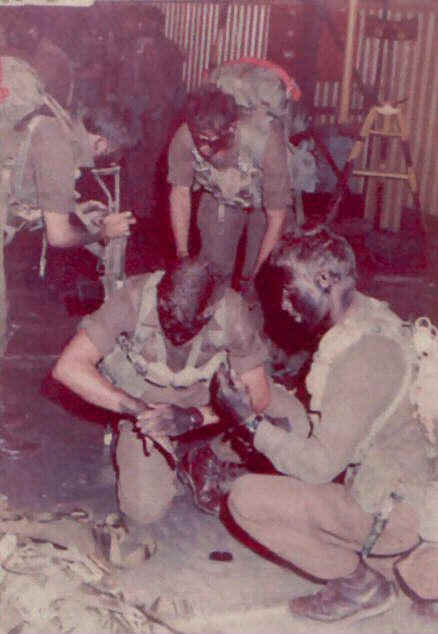 second last round was a tracer, RPG gunners checked their
missiles and made sure the safety pins were secure , the mortar
crews made sure the increment charges were dry. Breakfast
consisted of brown bread and coffee, not many had a meal , a
quick gulp of coffee, the rasp of a match, the flare of it
igniting, the flame cupped in two hands highlighting the matchbox
with the Lion Match Company logo, a drawn and haggard face
dipping towards it, with a Lucky Strike, Texan, Gunston,
Venus, Lexington, Rothmans, Van Rhyn, or Benson and Hedges pursed
between its lips, the sharp inhalation, and the angles and planes
of each mans face in bas relief as he lit up.
second last round was a tracer, RPG gunners checked their
missiles and made sure the safety pins were secure , the mortar
crews made sure the increment charges were dry. Breakfast
consisted of brown bread and coffee, not many had a meal , a
quick gulp of coffee, the rasp of a match, the flare of it
igniting, the flame cupped in two hands highlighting the matchbox
with the Lion Match Company logo, a drawn and haggard face
dipping towards it, with a Lucky Strike, Texan, Gunston,
Venus, Lexington, Rothmans, Van Rhyn, or Benson and Hedges pursed
between its lips, the sharp inhalation, and the angles and planes
of each mans face in bas relief as he lit up.
Each man checked and
rechecked his buddies gear and by 04H15 the Bats started
towards their respective transports, once everybody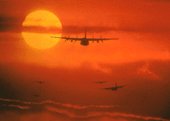 was in place,
the hatches hissed shut, the starters whined, the
propellers revolving slowly at first, and then the four Allison
AE 21 00D3 on the C-130's and the two Rolls Royce Tyne 22
Turboprops on the C-161's roared into life,
filling the air with sound.
was in place,
the hatches hissed shut, the starters whined, the
propellers revolving slowly at first, and then the four Allison
AE 21 00D3 on the C-130's and the two Rolls Royce Tyne 22
Turboprops on the C-161's roared into life,
filling the air with sound.
The planes lumbered down the runway
picking up speed, and suddenly they were in their element ,
winging eastwards on the first leg toward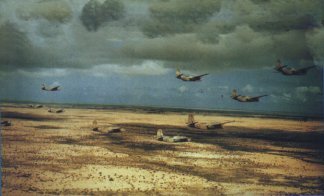 s their target. One of the occupants was reminded
of the song of the first soldiers who went into battle as
paratroopers in 1940, the "Fallschirmjäger :- Rot
Scheint die Sonne ...."as he glimpsed the rising sun
through a window in the Hercules. He had decided to
become a paratrooper when he was 14 after reading " Die
Valskerm Battaljon " a novel about the German Para
s their target. One of the occupants was reminded
of the song of the first soldiers who went into battle as
paratroopers in 1940, the "Fallschirmjäger :- Rot
Scheint die Sonne ...."as he glimpsed the rising sun
through a window in the Hercules. He had decided to
become a paratrooper when he was 14 after reading " Die
Valskerm Battaljon " a novel about the German Para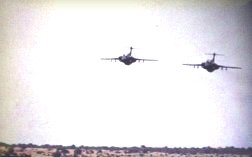 troopers at Monte Cassino, now he wasn't sure that had been
such a good idea. As soon as light allowed the Taskforce dropped
to the deck to avoid Angolan radar, this tactic also served
another purpose, should they overfly an enemy force, they would
be long gone before someone could fire at them.At 05H19 the 4 Canberra
Bombers took off from Waterkloof Air Force base in Pretoria, when
they reached Rundu in South West Africa, they made a dog leg northwest and headed towards Cassinga , 20 minutes
later 4 Buccaneers of 24 Squadron followed, the 5th was delayed
by a mechanical problem but followed soon thereafter.
troopers at Monte Cassino, now he wasn't sure that had been
such a good idea. As soon as light allowed the Taskforce dropped
to the deck to avoid Angolan radar, this tactic also served
another purpose, should they overfly an enemy force, they would
be long gone before someone could fire at them.At 05H19 the 4 Canberra
Bombers took off from Waterkloof Air Force base in Pretoria, when
they reached Rundu in South West Africa, they made a dog leg northwest and headed towards Cassinga , 20 minutes
later 4 Buccaneers of 24 Squadron followed, the 5th was delayed
by a mechanical problem but followed soon thereafter.
At the time
the eight transports were lifting off another Buccaneer armed
with 72 68mm SNEB rockets had departed from Waterkloof to
Grootfontein where it would remain on standb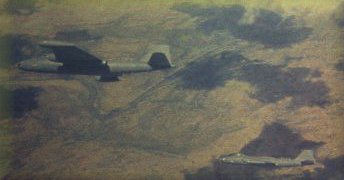 y for close support
if required. Two Puma helicopters departed from Omauni at the
same time to set up the HAA about 22 klicks east of Cassinga .
The pilot flying the first was Commandant James Klerk who would
be in charge of the Rotary Wing element of the operation. To
maintain the element of surprise it had been decided not to do a
ground reconnaissance, this in itself carried the risk that there
might be a Unita presence who might mistake the choppers for
Angolan ones, or worse a FAPLA one, which would compromise
the operation. To cap it all one of the passengers in the first
chopper was Lieutenant-General Constand Viljoen. It would be a
massive propaganda coup for South Africa's enemies if he was to
be killed or worse still captured. Viljoen was no shrinking
violet, like his predecessors in the Anglo Boer War he believed
in leading from the front. This habit of his almost got him
killed during operation Reindeer when he got blown out of the
hatch of a Ratel when this hit a TM46 anti tank mine.
y for close support
if required. Two Puma helicopters departed from Omauni at the
same time to set up the HAA about 22 klicks east of Cassinga .
The pilot flying the first was Commandant James Klerk who would
be in charge of the Rotary Wing element of the operation. To
maintain the element of surprise it had been decided not to do a
ground reconnaissance, this in itself carried the risk that there
might be a Unita presence who might mistake the choppers for
Angolan ones, or worse a FAPLA one, which would compromise
the operation. To cap it all one of the passengers in the first
chopper was Lieutenant-General Constand Viljoen. It would be a
massive propaganda coup for South Africa's enemies if he was to
be killed or worse still captured. Viljoen was no shrinking
violet, like his predecessors in the Anglo Boer War he believed
in leading from the front. This habit of his almost got him
killed during operation Reindeer when he got blown out of the
hatch of a Ratel when this hit a TM46 anti tank mine.
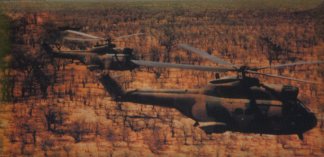 As the choppers reached the HAA Viljoen was the
first one out and to everyone's relief there was nobody around.
Radio beacons were put out should the strike aircraft need any
navigational aid and the all clear was signaled to Ondangwa . In
the meantime, back at Omauni, ten Pumas and five Super Frelons
carrying a protected element of forty two men plus a medical team
and extra fuel were getting ready to leave at 07H00. The South
Africans had perfected this tactic of setting up a HAA far behind
enemy lines during the Rhodesian War, where they assisted Ian
Smiths government in cross border strikes against Zanla and
Zipra.
As the choppers reached the HAA Viljoen was the
first one out and to everyone's relief there was nobody around.
Radio beacons were put out should the strike aircraft need any
navigational aid and the all clear was signaled to Ondangwa . In
the meantime, back at Omauni, ten Pumas and five Super Frelons
carrying a protected element of forty two men plus a medical team
and extra fuel were getting ready to leave at 07H00. The South
Africans had perfected this tactic of setting up a HAA far behind
enemy lines during the Rhodesian War, where they assisted Ian
Smiths government in cross border strikes against Zanla and
Zipra.
In the meantime the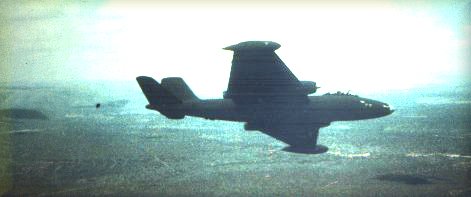 Task Force carrying
the Paratroopers went in to a holding pattern over the higher
reaches of the Cubango river waiting for the Canberra's to start
their bombing runs on Cassinga. The Canberra's were keeping
well to the east and made sure that they were overshooting the
target
Task Force carrying
the Paratroopers went in to a holding pattern over the higher
reaches of the Cubango river waiting for the Canberra's to start
their bombing runs on Cassinga. The Canberra's were keeping
well to the east and made sure that they were overshooting the
target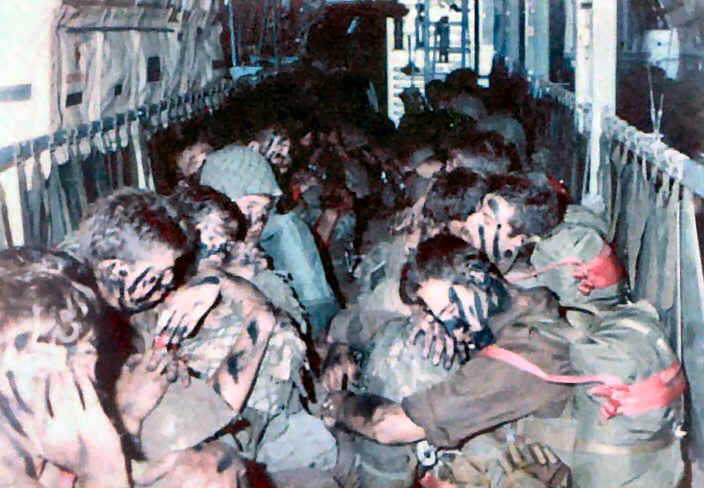 as not to alert the ground defenses, once they had reached
a point 20 nautical miles north east of Cassinga they turned back
on themselves and at 08H00 they crossed the town from north to
south at 350 meters and commenced their bombing run. The target
disappeared in a welter of smoke and flame and for those on the
ground it seemed that hell itself had engulfed them. The Golf
bombs functioned exactly as they were designed to do, bouncing up
in to the air and then exploding sending needle sharp pieces of
shrapnel slicing through flesh and bone, it was now time for
SWAPO and their followers to experience the horrors at first
hand, which they had visited so many times on defenseless
civilians in South West Africa. Trucks burst in to flame,
buildings collapsed and a plume of dust and smoke rose in to the
early morning sky.
as not to alert the ground defenses, once they had reached
a point 20 nautical miles north east of Cassinga they turned back
on themselves and at 08H00 they crossed the town from north to
south at 350 meters and commenced their bombing run. The target
disappeared in a welter of smoke and flame and for those on the
ground it seemed that hell itself had engulfed them. The Golf
bombs functioned exactly as they were designed to do, bouncing up
in to the air and then exploding sending needle sharp pieces of
shrapnel slicing through flesh and bone, it was now time for
SWAPO and their followers to experience the horrors at first
hand, which they had visited so many times on defenseless
civilians in South West Africa. Trucks burst in to flame,
buildings collapsed and a plume of dust and smoke rose in to the
early morning sky.
As soon as the Canberra's
had finished their bombing run the Buccaneers came barreling in
at 150 meters and dropped their 450Kg HE Bombs in to the raging
inferno below. Three of them were tasked to hit the town and one
was assigned the veterans camp. This plane completely missed its
target but the two Mirage III's hosed the whole camp with 30mm
cannon fire. The leader of the Buccaneer force made a circuit and
reported that a 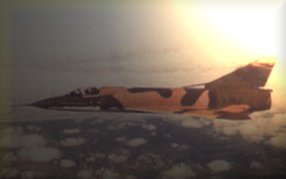 considerable amount of damage had been done to the target
especially towards the east of the Techamutete road. A major part
of the base was burning fiercely and through the smoke he saw
that a lot of the infrastructure had been damaged. On the ground
scores of terrorists were lying dead or wounded, the camp
reminded him of a ants nest that had been disturbed with people
running to and fro, the wounded and maimed writhing in
agony in the vicinity of the area immediately east of the
road and around the parade ground. Fortune had smiled on
the South Africans this day as their attack coincided with a
parade on the parade ground. It has since been speculated that
this was a routine roll call and according to SWAPO itself most
of the 4098 terrorists had gathered there that morning just
before the attack had taken place. Despite SWAPO's protestations
that Cassinga was a so called " refugee camp", most of
the dead, both men and women, were wearing olive green Cuban
uniforms, very few bodies were dressed in civilian clothes. So
much for their "refugee status" claim.
considerable amount of damage had been done to the target
especially towards the east of the Techamutete road. A major part
of the base was burning fiercely and through the smoke he saw
that a lot of the infrastructure had been damaged. On the ground
scores of terrorists were lying dead or wounded, the camp
reminded him of a ants nest that had been disturbed with people
running to and fro, the wounded and maimed writhing in
agony in the vicinity of the area immediately east of the
road and around the parade ground. Fortune had smiled on
the South Africans this day as their attack coincided with a
parade on the parade ground. It has since been speculated that
this was a routine roll call and according to SWAPO itself most
of the 4098 terrorists had gathered there that morning just
before the attack had taken place. Despite SWAPO's protestations
that Cassinga was a so called " refugee camp", most of
the dead, both men and women, were wearing olive green Cuban
uniforms, very few bodies were dressed in civilian clothes. So
much for their "refugee status" claim.
32 Battalion
PAGE II
Copyright Cobus Venter 2001 - 2006
Borderstrike ! by Willem Steenkamp was used as a reference for the maps on this and page II